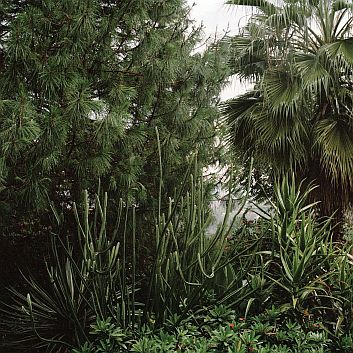Kenya, Visual Arts, 2020
Mimi
Cherono Ng'ok

A certain “green impulse” pervades the art of Mimi Cherono Ng’ok. It stems from the artist’s keen awareness that the environments we inhabit and traverse are ever vulnerable to unsuspecting forms of growth and decay. An avid traveler, Cherono Ng’ok engages such dynamics by tracking the intersections and mutable nature of built environments, botanical cultures, and social relations—all across vast geographies, primarily in the Global South. This has resulted in heterogeneous bodies of work allied by the artist’s openly personal perspective and her enduring preoccupation with the mnemonic dimensions of the photographic image.
Much of Cherono Ng’ok’s work over the past decade has a cerebral and self-reflexive character. Working with a medium format analog camera, the artist developed an ongoing practice of shooting daily for extended periods of time, recording the ordinary and fleeting moments that punctuate daily life in the tropics, both at home and during her journeys. Exterior spaces associated with transience emerged as a recurring theme, whether in photographing the facades of hotels and demolished architecture in Dakar, sidewalks and popular beaches in Accra, or thick accumulations of shrubbery on the streets of Nairobi. The trappings of domestic life is another leitmotif across imagery of interior spaces, ranging from portraits of friends reclining on floral bedspreads to images that evoke an unseen human presence: fresh-cut flowers, plated fruit, potted plants, and strewn clothing.
Examples of the foregoing work can be found in numerous exhibitions and biennials that have featured the artist’s work over the years—presentations typically guided by Cherono Ng’ok’s penchant for intuition and open-ended narratives. The artist’s photo installations are invariably unique and site-specific. Single images occasionally repeat in the same installation, and photographs from different spaces and times commingle without any apparent relation between them. The material form of her images is prone to mutation: prints are sometimes excised and collaged, and particular images are frequently displayed at a diminutive scale in one show, and amplified as large-scale vinyl wallpaper in the next. Such procedures reflect Cherono Ng’ok’s insistence on regarding images as organic matter whose form, like their content, is susceptible to transformation.
In recent years, Cherono Ng’ok’s art has tackled more pointed subjects such as the medicinal properties of plants as well as their associations with romance and mourning. Her latest body of work focuses in particular on the consoling virtues of botanical culture, carrying subtle allusions to loss from both personal and environmental perspectives. Employing a range of media and sited across Nairobi, the Dominican Republic, and São Paulo, this new work explores the ways in which certain types of flora, by recurring across cities, provoke familiarity, and so mitigate feelings of anxiety and alienation that often come with traveling to new locales. The work thus models in miniature the overall vision of an artist whose practice unfurls through constant movement and absorbs all the fragility this entails.
Text: Antawan I. Byrd

